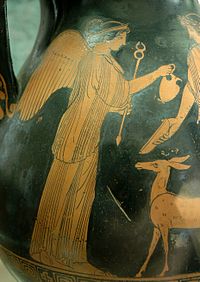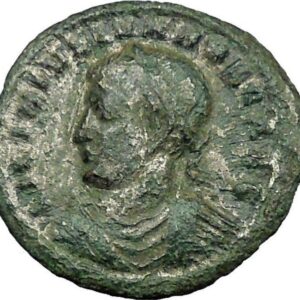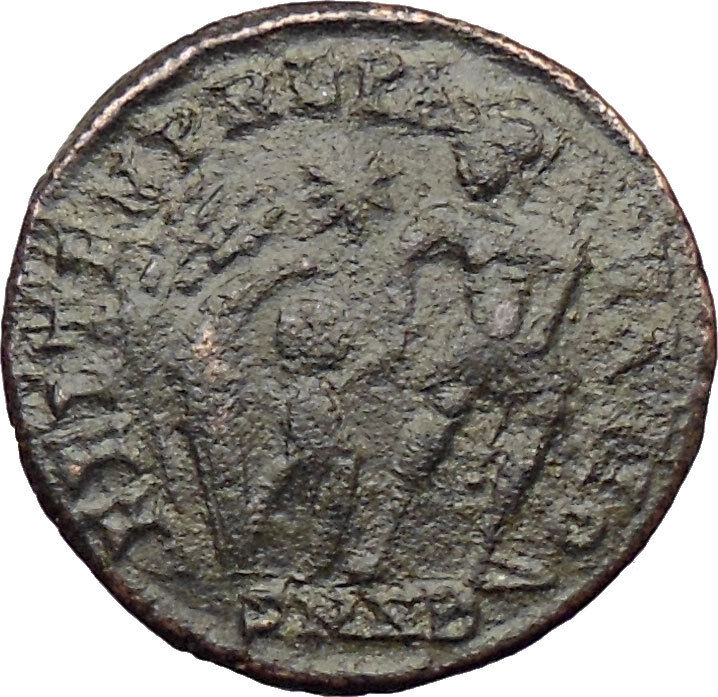|
Julia Mamaea
– Roman Empress wife of
Emperor Severus Alexander 222-235 A.D. –
Silver Denarius 19mm (2.67 grams) Rome mint: 222-235 A.D.
Reference: RIC 335 (Severus Alexander), S 8209
IVLIAMAMAEAAVG – Diademed, draped bust right.
FELICITASPVBLICA – Felicitas standing left, leaning on column and with legs
crossed,
holding caduceus.
You are bidding on the exact item pictured,
provided with a Certificate of Authenticity and Lifetime Guarantee of
Authenticity.
The caduceus from
Greek
“herald’s staff” is the staff carried by
Hermes
in
Greek mythology
. The same staff was also borne
by heralds in general, for example by
Iris
, the messenger of
Hera. It is a short staff entwined by two
serpents
, sometimes surmounted by wings. In
Roman iconography it was often depicted being carried in the left hand of
Mercury
, the messenger of the gods, guide of
the dead and protector of merchants, shepherds, gamblers, liars, and thieves.
As a symbolic object it represents Hermes (or the Roman Mercury), and by
extension trades, occupations or undertakings associated with the god. In later
Antiquity
the caduceus provided the basis for
the
astrological symbol
representing the
planet Mercury
. Thus, through its use in
astrology
and
alchemy
, it has come to denote the
elemental metal
of the same name.
By extension of its association with Mercury/Hermes, the caduceus is also a
recognized symbol of commerce and negotiation, two realms in which balanced
exchange and reciprocity are recognized as ideals. This association is ancient,
and consistent from the Classical period to modern times. The caduceus is also
used as a symbol representing printing, again by extension of the attributes of
Mercury (in this case associated with writing and eloquence).
The caduceus is sometimes mistakenly used
as a symbol of medicine and/or medical practice
,
especially in
North America
, because of widespread confusion
with the traditional medical symbol, the
rod of Asclepius
, which has only a single snake
and no wings.
The term kerukeion denoted any herald’s staff, not necessarily
associated with Hermes in particular.
Lewis Richard Farnell
(1909) in his study of
the cult of Hermes assumed that the two snakes had simply developed out of
ornaments of the shepherd’s crook used by heralds as their staff. This view has
been rejected by later authors pointing to parallel iconography in the Ancient
Near East. It has been argued that the staff or wand entwined by two snakes was
itself representing a god in the pre-anthropomorphic era. Like the
herm
or
priapus
, it would thus be a predecessor of the
anthropomorphic Hermes of the classical era.
Ancient Near East
William Hayes Ward
(1910) discovered that
symbols similar to the classical caduceus sometimes appeared on
Mesopotamian cylinder seals
. He suggested the
symbol originated some time between 3000 and 4000 BCE, and that it might have
been the source of the Greek caduceus.[10]
A.L. Frothingham incorporated Dr. Ward’s research into his own work, published
in 1916, in which he suggested that the prototype of Hermes was an “Oriental
deity of Babylonian extraction” represented in his earliest form as a snake god.
From this perspective, the caduceus was originally representative of Hermes
himself, in his early form as the Underworld god
Ningishzida
, “messenger” of the “Earth Mother”.
The caduceus is mentioned in passing by
Walter Burkert
[12]
as “really the image of copulating snakes taken over from Ancient Near Eastern
tradition”.
In Egyptian iconography, the
Djed pillar is depicted as containing a snake in a frieze of the
Dendera Temple complex
.
The rod of Moses
and the
brazen serpent
are frequently compared to the
caduceus, especially as Moses is acting as a messenger of God to the
Pharaoh
at the point in the narrative where he
changes his staff into a serpent.[13]
Classical antiquity
Mythology
The
Homeric hymn
to Hermes relates how Hermes
offered his lyre fashioned from a tortoise shell as compensation for the
cattle he stole
from his half brother
Apollo
. Apollo in return gave Hermes the
caduceus as a gesture of friendship. The association with the serpent thus
connects Hermes to Apollo
, as later the serpent was associated
with Asclepius
, the “son of Apollo”. The association
of Apollo with the serpent is a continuation of the older
Indo-European
dragon
-slayer motif.
Wilhelm Heinrich Roscher
(1913) pointed out
that the serpent as an attribute of both Hermes and Asclepius is a variant of
the “pre-historic semi-chthonic serpent hero known at Delphi as
Python
“, who in classical mythology is slain by
Apollo.
One Greek myth of origin
of the caduceus is part of the
story of Tiresias
, who found two snakes copulating and
killed the female with his staff. Tiresias was immediately turned into a woman,
and so remained until he was able to repeat the act with the male snake seven
years later. This staff later came into the possession of the god Hermes, along
with its transformative powers.
Another myth suggests that Hermes (or Mercury) saw two serpents entwined in
mortal combat. Separating them with his wand he brought about peace between
them, and as a result the wand with two serpents came to be seen as a sign of
peace.
In Rome, Livy
refers to the caduceator who
negotiated peace arrangements under the diplomatic protection of the caduceus he
carried.
Iconography
In some vase paintings ancient depictions of the Greek kerukeion are
somewhat different from the commonly seen modern representation. These
representations feature the two snakes atop the staff (or rod), crossed to
create a circle with the heads of the snakes resembling horns. This old graphic
form, with an additional crossbar to the staff, seems to have provided the basis
for the graphical
sign of Mercury
(☿) used in
Greek astrology
from Late Antiquity.
Use in alchemy
and occultism
As the symbol of both the
planet
and the
metal
named for Mercury, the caduceus became an
important symbol in
alchemy
.
The
crucified serpent
was also revived as an
alchemical symbol for
fixatio
, and
John Donne
(Sermons 10:190) uses
“crucified Serpent” as a title of
Jesus Christ
.
Symbol of commerce
A simplified variant of the caduceus is to be found in dictionaries,
indicating a “commercial term” entirely in keeping with the association of
Hermes with commerce. In this form the staff is often depicted with two winglets
attached and the snakes are omitted (or reduced to a small ring in the middle).
The Customs Service of the former
German Democratic Republic
employed the
caduceus, bringing its implied associations with thresholds, translators, and
commerce, in the service medals they issued their staff.
Misuse as symbol
of medicine
It is relatively common, especially in the United States, to find the
caduceus, with its two snakes and wings, used as a symbol of medicine instead of
the correct rod of Asclepius, with only a single snake. This usage is erroneous,
popularised largely as a result of the adoption of the caduceus as its insignia
by the
US Army medical corps
in 1902 at the insistence
of a single officer (though there are conflicting claims as to whether this was
Capt. Frederick P. Reynolds or Col. John R. van Hoff).
The rod of Asclepius is the dominant symbol for professional healthcare
associations in the United States. One survey found that 62% of professional
healthcare associations used the rod of Asclepius as their symbol. The same
survey found that 76% of commercial healthcare organizations used the Caduceus
symbol. The author of the study suggests the difference exists because
professional associations are more likely to have a real understanding of the
two symbols, whereas commercial organizations are more likely to be concerned
with the visual impact a symbol will have in selling their products.
The initial errors leading to its adoption and the continuing confusion it
generates are well known to medical historians. The long-standing and abundantly
attested historical associations of the caduceus with commerce, theft,
deception, and death are considered by many to be inappropriate in a symbol used
by those engaged in the healing arts. This has occasioned significant criticism
of the use of the caduceus in a medical context.
In
Roman mythology
, Felicitas (meaning “good luck” or “fortune”) was the
goddess or personification of good luck and success. The word felicitas, “luck”, is also the source of the word and name
felicity. She played an important
role in
Rome’s state religion
during the
empire
,
and was frequently portrayed on
coins
. She became a prominent symbol of the wealth and prosperity of the
Roman
Empire
.
Felicitas was unknown before the mid-2nd century BC, when a temple was
dedicated to her in the
Velabrum
in
the Campus Martius
by
Lucius Licinius Lucullus
, using booty from his 151–150 BC campaign in Spain.
The temple was destroyed by a fire during the reign of
Claudius
and was never rebuilt.
Another temple in Rome
was planned by
Julius Caesar
and was erected after his death by
Marcus Aemilius Lepidus
on the site of the
Curia Hostilia
, which had been restored by
Lucius Cornelius Sulla
but demolished by Caesar in 44 BC. This temple no
longer existed by the time of
Hadrian
, and
its site probably lies under the church of
Santi Martina e Luca
.
Julia
Avita Mamaea (14 or 29 August after 180–235) was the second daughter of
Julia
Maesa
, a powerful
 Roman woman of Syrian Roman woman of Syrian
Arab
origin and Syrian noble
Julius Avitus
. She was a niece of empress
Julia
Domna
and
emperor
Septimius Severus
and sister of
Julia Soaemias
. She was born and raised in
Emesa
(modern
Homs
, Syria
).
Julia’s first husband was a former consul (whose name is unknown) who died.
Julia married as her second husband Syrian
Promagistrate
Marcus Julius Gessius Marcianus
. Julia bore Marcianus two children, a
daughter called Theoclia (little is known of her) and a son, Marcus Julius
Gessius Bassianus Alexianus, later emperor
Alexander Severus
. Unlike her sister, Julia Mamaea was reported to be a
virtuous woman, never involved in scandals.
As a member of the Imperial Roman family, she watched closely the death of
her cousin Caracalla
and the ascent to power of her nephew
Elagabalus
,
the oldest grandson of Julia Maesa and her choice to the throne. Eventually
Elagabalus and his mother Julia Soaemias proved incompetent rulers and favour
fell on Alexander, Julia’s son. He became emperor in 222, following Elagabalus’
murder by the
Praetorian Guard
. Julia and her mother became regents in the name of
Alexander, then 14 years old. Upon adulthood, Alexander confirmed his esteem for
his mother and named her consors imperii (imperial consort). It was in
this condition that she accompanied her son in his campaigns: a custom started
with Julia Domna
. Thus she travelled to the East, for the campaign against
Parthia
and
to the Germania provinces. Julia Mamaea was with Alexander in Moguntiacum
(modern Mainz
),
capital of
Germania Superior
, when he was assassinated by his troops. She suffered the
same fate.
|







 Roman woman of Syrian
Roman woman of Syrian


